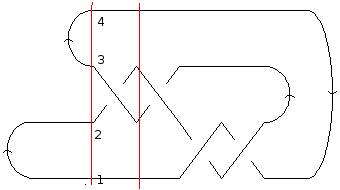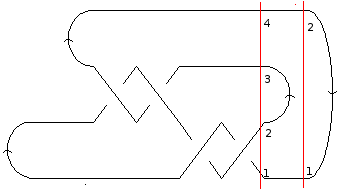MorseLink Presentations: Difference between revisions
(Minor touchup.) |
|||
| (2 intermediate revisions by the same user not shown) | |||
| Line 1: | Line 1: | ||
{{Manual TOC Sidebar}} |
{{Manual TOC Sidebar}} |
||
The MorseLink presentation describes an oriented knot or link diagram as a sequence of 'events'. To begin, we fix an axis in the plane, so that each event in the MorseLink description occurs in successive intervals along this axis. The 'events' that comprise a knot or link are 'cups' (creations), 'caps' (annihilations), and crossings, where cups and caps are the minima and maxima (respectively) relative to the chosen axis. The conventions used by MorseLink are as follows: |
The MorseLink presentation describes an oriented knot or link diagram as a sequence of 'events'. To begin, we fix an axis in the plane, so that each event in the MorseLink description occurs in successive intervals along this axis. The 'events' that comprise a knot or link are 'cups' (creations), 'caps' (annihilations), and crossings, where cups and caps are the minima and maxima (respectively) relative to the chosen axis. The conventions used by MorseLink are as follows: |
||
| Line 16: | Line 15: | ||
| ⚫ | [[Image:MLPres2.png|250px|left|Two cap events]]After three more crossings, we encounter two cap events. The first annihilates strands 2 and 3, and is directed from 2 to 3. The second annihilates strands 1 and 2, but is directed from 2 to 1. So the MorseLink presentation for the knot [[4_1]] is given by: <code>MorseLink[Cup[1,2], Cup[3,4], X[2 , Under, Up, Down], X[2, Under, Down, Up], X[1, Over, Down, Up], X[1, Over, Up, Down], Cap[2,3], Cap[2,1]]</code>. |
||
| ⚫ | [[Image:MLPres2.png|250px| |
||
<br style="clear:both" /> |
|||
====Further notes==== |
====Further notes==== |
||
KnotTheory` knows about Morse link presentations: |
|||
{{Startup Note}} |
{{Startup Note}} |
||
<!--$$?MorseLink$$--> |
<!--$$?MorseLink$$--> |
||
<!--Robot Land, no human edits to "END"--> |
<!--Robot Land, no human edits to "END"--> |
||
{{HelpAndAbout| |
{{HelpAndAbout| |
||
n = |
n = 2 | |
||
n1 = |
n1 = 3 | |
||
in = <nowiki>MorseLink</nowiki> | |
in = <nowiki>MorseLink</nowiki> | |
||
out= <nowiki>MorseLink[K] returns a presentation of the oriented link K, composed, in successive order, of the following 'events': Cup[m,n] is a directed creation, starting at strand position n, towards position m, where m and n differ by 1. X[n,a = {Over/Under}, b = {Up/Down}, c={Up/Down}] is a crossing with lower-left edge at strand n, a determines whether the strand running bottom-left to top-right is over/under the crossing, b and c give the directions of the bottom-left and bottom-right strands respectively through the crossing. Cap[m,n] is a directed cap, from strand m to strand n.</nowiki> | |
out= <nowiki>MorseLink[K] returns a presentation of the oriented link K, composed, in successive order, of the following 'events': Cup[m,n] is a directed creation, starting at strand position n, towards position m, where m and n differ by 1. X[n,a = {Over/Under}, b = {Up/Down}, c={Up/Down}] is a crossing with lower-left edge at strand n, a determines whether the strand running bottom-left to top-right is over/under the crossing, b and c give the directions of the bottom-left and bottom-right strands respectively through the crossing. Cap[m,n] is a directed cap, from strand m to strand n.</nowiki> | |
||
Latest revision as of 17:06, 17 July 2007
The MorseLink presentation describes an oriented knot or link diagram as a sequence of 'events'. To begin, we fix an axis in the plane, so that each event in the MorseLink description occurs in successive intervals along this axis. The 'events' that comprise a knot or link are 'cups' (creations), 'caps' (annihilations), and crossings, where cups and caps are the minima and maxima (respectively) relative to the chosen axis. The conventions used by MorseLink are as follows:
- Cup[m,n] represents a creation, where the new strands are in position m and n, with m and n differing by 1, and is directed from m to n.
- Cap[m,n] represents an annihilation of the strands m and n, again with m and n differing by 1, and is directed from m to n.
- X[n, d, a, b] is a crossing of the n-th and the (n+1)-th strands. 'd' signifies whether the n-th strand goes 'Over' or 'Under' the (n+1)-th strand. 'a' indicates whether the n-th strand is moving 'Up' or 'Down' through the crossing, relative to the chosen axis; 'b' does the same for the (n+1)-th strand.
For concreteness, let us find a MorseLink presentation of the knot 4_1, based on the following diagram:

We fix the chosen axis to be the positive axis, and we number the strands at each interval from bottom to top. Clearly the first event to take place is a cup, creating strands 1 and 2, and directed from 1 to 2. The next event is also a cup; this time, the strands 3 and 4 are created, from 3 to 4. So the first two elements of our MorseLink presentation are {Cup[1,2], Cup[3,4], ...}.
The next event to take place is a crossing. This crossing has strand 2 going under strand 3; following the orientations, strand 2 moves to the right through the crossing, while strand 3 comes from the left. Since the chosen axis is pointing to the right, this event is described as X[2, Under, Up, Down]. We may proceed in a similar way for the rest of the crossings.
After three more crossings, we encounter two cap events. The first annihilates strands 2 and 3, and is directed from 2 to 3. The second annihilates strands 1 and 2, but is directed from 2 to 1. So the MorseLink presentation for the knot 4_1 is given by: MorseLink[Cup[1,2], Cup[3,4], X[2 , Under, Up, Down], X[2, Under, Down, Up], X[1, Over, Down, Up], X[1, Over, Up, Down], Cap[2,3], Cap[2,1]].
Further notes
KnotTheory` knows about Morse link presentations: (For In[1] see Setup)
|
| ||||||||
- Obviously, there is no unique Morse link presentation for a knot. One presentation may be considered 'better' than another if it generally has fewer strands. Unfortunately, this program makes only a half-hearted attempt in coming up with such presentations; it does a creation only when it can no longer do any caps or crossings, but exhibits a lack of foresight into which edges to create.


